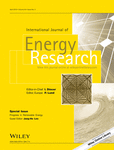Optimization of blade setting angles of a counter-rotating type horizontal-axis tidal turbine using response surface methodology and experimental validation
Summary
This paper describes an optimization method for blade setting angles of a counter-rotating type horizontal-axis tidal turbine (HATT). Both of the front and rear blades were designed by the traditional blade element momentum (BEM) theory, which fails to simulate the interaction between the dual rotors. However, the computational fluid dynamics (CFD) analysis can predict the mutual performance accurately to make up the drawback of BEM theory. A second-order response surface methodology (RSM) with the aid of three-dimensional Reynolds-averaged Navier–Stokes (RANS) analysis was employed to obtain the optimal match of front and rear blade setting angles. Furthermore, experimental tests in the wind tunnel were carried out to verify the numerical predictions. The performance of the optimal turbine has been proven to be greatly improved by both of CFD predictions and experimental results. Copyright © 2015 John Wiley & Sons, Ltd.




